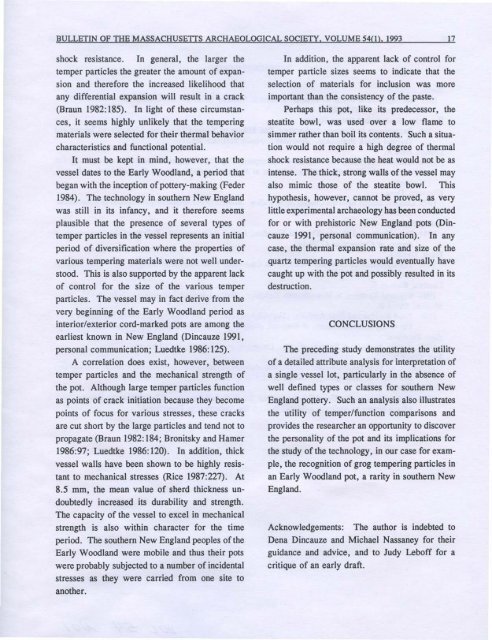Bulletin of the Massachusetts Archaeological Society, Vol. 54, No. 1 ...
Bulletin of the Massachusetts Archaeological Society, Vol. 54, No. 1 ...
Bulletin of the Massachusetts Archaeological Society, Vol. 54, No. 1 ...
Create successful ePaper yourself
Turn your PDF publications into a flip-book with our unique Google optimized e-Paper software.
BULLETIN OF THE MASSACHUSETIS ARCHAEOLOGICAL SOCIETY, VOLUME <strong>54</strong>(1), 1993 17<br />
shock resistance. In general, <strong>the</strong> larger <strong>the</strong><br />
temper particles <strong>the</strong> greater <strong>the</strong> amount <strong>of</strong> expansion<br />
and <strong>the</strong>refore <strong>the</strong> increased likelihood that<br />
any differential expansion will result in a crack<br />
(Braun 1982: 185). In light <strong>of</strong> <strong>the</strong>se circumstances,<br />
it seems highly unlikely that <strong>the</strong> tempering<br />
materials were selected for <strong>the</strong>ir <strong>the</strong>rmal behavior<br />
characteristics and functional potential.<br />
It must be kept in mind, however, that <strong>the</strong><br />
vessel dates to <strong>the</strong> Early Woodland, a period that<br />
began with <strong>the</strong> inception <strong>of</strong>pottery-making (Feder<br />
1984). The technology in sou<strong>the</strong>rn New England<br />
was still in its infancy, and it <strong>the</strong>refore seems<br />
plausible that <strong>the</strong> presence <strong>of</strong> several types <strong>of</strong><br />
temper particles in <strong>the</strong> vessel represents an initial<br />
period <strong>of</strong> diversification where <strong>the</strong> properties <strong>of</strong><br />
various tempering materials were not well understood.<br />
This is also supported by <strong>the</strong> apparent lack<br />
<strong>of</strong> control for <strong>the</strong> size <strong>of</strong> <strong>the</strong> various temper<br />
particles. The vessel may in fact derive from <strong>the</strong><br />
very beginning <strong>of</strong> <strong>the</strong> Early Woodland period as<br />
interior/exterior cord-marked pots are among <strong>the</strong><br />
earliest known in New England (Dincauze 1991,<br />
personal communication; Luedtke 1986: 125).<br />
A correlation does exist, however, between<br />
temper particles and <strong>the</strong> mechanical strength <strong>of</strong><br />
<strong>the</strong> pot. Although large temper particles function<br />
as points <strong>of</strong> crack initiation because <strong>the</strong>y become<br />
points <strong>of</strong> focus for various stresses, <strong>the</strong>se cracks<br />
are cut short by <strong>the</strong> large particles and tend not to<br />
propagate (Braun 1982: 184; Bronitsky and Hamer<br />
1986:97; Luedtke 1986:120). In addition, thick<br />
vessel walls have been shown to be highly resistant<br />
to mechanical stresses (Rice 1987:227), At<br />
8.5 mm, <strong>the</strong> mean value <strong>of</strong> sherd thickness undoubtedly<br />
increased its durability and strength,<br />
The capacity <strong>of</strong> <strong>the</strong> vessel to excel in mechanical<br />
strength is also within character for <strong>the</strong> time<br />
period. The sou<strong>the</strong>rn New England peoples <strong>of</strong><strong>the</strong><br />
Early Woodland were mobile and thus <strong>the</strong>ir pots<br />
were probably subjected to a number <strong>of</strong> incidental<br />
stresses as <strong>the</strong>y were carried from one site to<br />
ano<strong>the</strong>r.<br />
In addition, <strong>the</strong> apparent lack <strong>of</strong> control for<br />
temper particle sizes seems to indicate that <strong>the</strong><br />
selection <strong>of</strong> materials for inclusion was more<br />
important than <strong>the</strong> consistency <strong>of</strong> <strong>the</strong> paste,<br />
Perhaps this pot, like its predecessor, <strong>the</strong><br />
steatite bowl, was used over a low flame to<br />
simmer ra<strong>the</strong>r than boil its contents. Such a situation<br />
would not require a high degree <strong>of</strong> <strong>the</strong>rmal<br />
shock resistance because <strong>the</strong> heat would not be as<br />
intense, The thick, strong walls <strong>of</strong> <strong>the</strong> vessel may<br />
also mimic those <strong>of</strong> <strong>the</strong> steatite bowl. This<br />
hypo<strong>the</strong>sis, however, cannot be proved, as very<br />
little experimental archaeology has been conducted<br />
for or with prehistoric New England pots (Dincauze<br />
1991, personal communication). In any<br />
case, <strong>the</strong> <strong>the</strong>rmal expansion rate and size <strong>of</strong> <strong>the</strong><br />
quartz tempering particles would eventually have<br />
caught up with <strong>the</strong> pot and possibly resulted in its<br />
destruction.<br />
CONCLUSIONS<br />
The preceding study demonstrates <strong>the</strong> utility<br />
<strong>of</strong>a detailed attribute analysis for interpretation <strong>of</strong><br />
a single vessel lot, particularly in <strong>the</strong> absence <strong>of</strong><br />
well defined types or classes for sou<strong>the</strong>rn New<br />
England pottery. Such an analysis also illustrates<br />
<strong>the</strong> utility <strong>of</strong> temper/function comparisons and<br />
provides <strong>the</strong> researcher an opportunity to discover<br />
<strong>the</strong> personality <strong>of</strong> <strong>the</strong> pot and its implications for<br />
<strong>the</strong> study <strong>of</strong> <strong>the</strong> technology, in our case for example,<br />
<strong>the</strong> recognition <strong>of</strong> grog tempering particles in<br />
an Early Woodland pot, a rarity in sou<strong>the</strong>rn New<br />
England.<br />
Acknowledgements: The author is indebted to<br />
Dena Dincauze and Michael Nassaney for <strong>the</strong>ir<br />
guidance and advice, and to Judy Leb<strong>of</strong>f for a<br />
critique <strong>of</strong> an early draft.
















